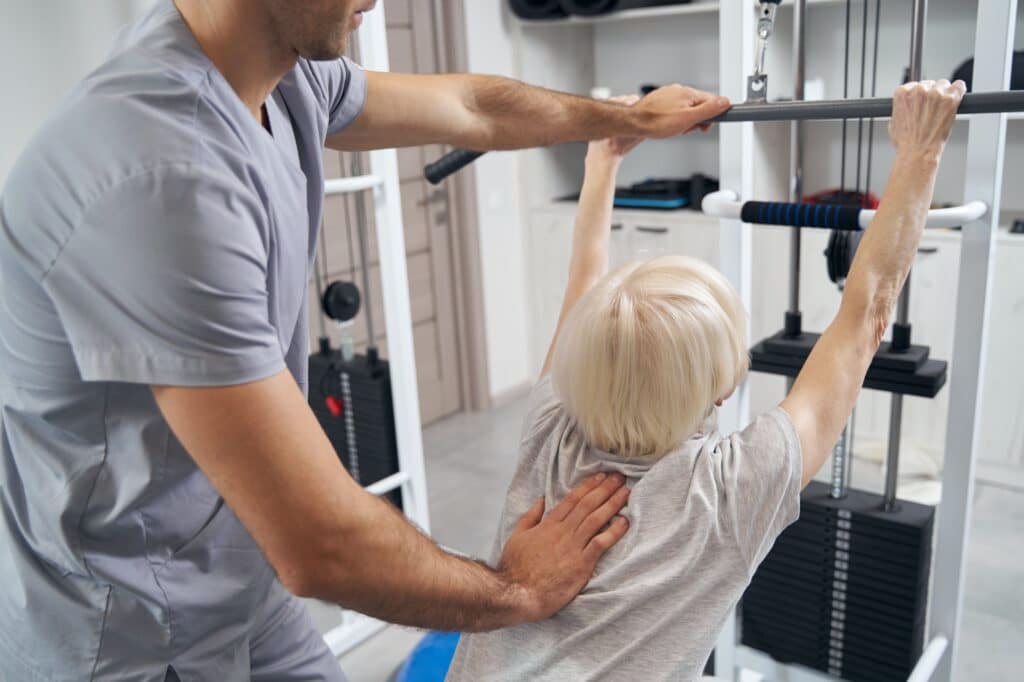Upper Cross Syndrome (UCS) is a common yet often misunderstood condition that arises from poor postural habits. Characterized by a forward head posture and rounded shoulders, UCS can lead to chronic neck pain, reduced mobility, and even functional disability.
This comprehensive guide delves into the causes, symptoms, and effective treatment strategies for Upper Cross Syndrome. Whether you’re a desk worker, an athlete, or someone experiencing unexplained neck and upper back discomfort, understanding and addressing UCS is crucial for maintaining spinal health and overall well-being.
What is Upper Cross Syndrome?

Upper cross syndrome (also called upper crossed syndrome, or UCS) is caused by forward head posture, which happens when your neck cranes forward and your shoulders round.
Usually, your neck or cervical spine should have a slight curve, known as cervical lordosis. Poor posture can increase the curve, causing your head and neck to jut forward.
With each degree forward, gravity weighs your head down, which makes your neck muscles work even harder to keep your head straight so you can see the world.
The imbalance of tight and weak muscles can begin as temporary acute pain but become chronic over time. Chronic neck pain can lead to functional disability and difficulty performing work or daily activities. This is known as mechanical neck pain.
UCS also involves the shoulder structures and is often accompanied by a hunched upper back (or thoracic kyphosis) from underactive and overactive muscles.
With a forward head posture, the shoulder blades flare out and tip forward, causing rounded shoulders. This decreases the stability of your shoulder joint, causing difficulty in performing basic movements like reaching or carrying objects.
The basic ability to maintain an upright, proper posture can become painful and difficult when you’re struggling with UCS.
Note: UCS is classified as a syndrome since this continuous forward head position is considered “abnormal” compared to a regular, upright posture.
What Causes Upper Cross Syndrome?

Muscles work their best at optimal lengths, and tight or weak muscles can become inhibited or dysfunctional. This is known as a muscular imbalance.
Several areas of your upper body can be affected by UCS, including:
- Tight pectoral muscles in your chest abnormally draw your shoulders forward.
- Tightness in your upper trapezius muscles and levator scapulae muscles in the back of your neck might elevate your shoulder blades up towards the ears.
- Weak shoulder blade stabilizers inhibit raising your arms up, pushing, pulling, and carrying objects.
- Tight suboccipital muscles at the base of your skull can cause headaches due to compression of the nerves in that area.
- The muscles in the front of your neck, the scalenes and sternocleidomastoid, help you breathe during higher activity levels. Tightness in this area can lead to breathing difficulty, favoring accessory muscles over deep belly breathing muscles, namely the diaphragm.
- Scapular winging is a type of dysfunction commonly due to weakness in the serratus anterior muscles under your shoulder blade, in which the shoulder blade juts out like a “wing.”
- Lastly, the deep neck flexors under your chin can weaken and be overstretched due to the head-jutting-forward position.
The muscles around your shoulder blades and upper back are also affected, influencing your shoulder range of motion and stability.
Rounded shoulders cause weakness in the muscles around the shoulder blades – your serratus anterior, rhomboid, and middle and lower trapezius muscles.
In all these areas, when one muscle is weak, another is overly tightened, resulting in a cycle of muscle imbalance.
Now that you know some of the affected areas, let’s look at the symptoms of UCS.
Upper Cross Syndrome Symptoms
Upper Cross Syndrome (UCS) presents a range of symptoms that can significantly impact daily life, with neck pain and forward head posture being the most common. Individuals with UCS often experience neck and upper back discomfort, which becomes particularly evident when performing actions like turning the head – a movement frequently required while driving.
Additionally, UCS can lead to tightness in the neck or chest, often accompanied by shortness of breath or tension headaches. These symptoms may cause discomfort and contribute to a decrease in overall well-being and daily functioning.
Many experiencing UCS also report numbness or tingling sensations in the arms or hands. This can be particularly concerning as it may interfere with fine motor skills and the ability to carry out everyday tasks effectively.
A decreased range of motion in the upper back or shoulders is another symptom, often making it painful or difficult to maintain certain positions for extended periods, such as sitting at a desk. This limitation can hinder one’s ability to work or engage in recreational activities comfortably.
It’s important to note that while some individuals may experience a combination of these symptoms, others might only suffer from specific issues, such as isolated neck pain or difficulty in turning their heads while driving.
The presence of even one of these symptoms can be indicative of Upper Cross Syndrome. Therefore, it’s crucial to recognize and address them to improve one’s quality of life and prevent further complications.
How Is Upper Crossed Syndrome Diagnosed?
Your physical therapist or doctor will use both a description of your symptoms and an evaluation to determine if you have UCS.
For example, a diagnosis of upper cross syndrome is likely due to a lack of regular exercise, excessive computer use, manual work with repetitive upper body tasks, or constant bending forward.
Your physical therapist will also test your neck, upper back, and shoulder strength and flexibility and complete a postural assessment. Poor posture is the most significant indicator that muscle imbalances contribute to neck or upper back pain.
Tightness or tenderness to touch during a physical assessment can also indicate UCS.
Next, we’ll explore strategies you can use daily to improve your posture and decrease pain.
Upper Cross Syndrome Treatment

Physical therapy is a valuable approach for addressing the symptoms and pain associated with upper cross syndrome (UCS). A comprehensive physical therapy regimen may encompass a variety of techniques and exercises, each targeting different aspects of the condition.
The Basics: Manual Therapy, Stretching and Strengthening
The treatment plan often begins with manual therapy, which includes soft tissue massage and joint mobilizations. These techniques help alleviate tension and enhance joint mobility, offering immediate relief in some cases.
Stretching exercises are a cornerstone of therapy, focusing on the tight muscles in the neck, upper back, and shoulders. These stretches are crucial for alleviating muscle stiffness and improving flexibility, thereby reducing the discomfort associated with UCS.
In parallel, strengthening exercises are tailored to reinforce the weaker muscles in the same areas. The therapy aims to correct muscle imbalances that contribute to UCS by building strength in these muscles.
Focus on Specific Symptoms for Relief
Stabilization exercises are another critical component to improve posture and enhance the body’s weight-bearing capabilities. These exercises train the body to maintain a healthy alignment, reducing strain on the musculoskeletal system.
Functional exercises are also incorporated, emphasizing motor control and proper muscle activation. These exercises are designed to retrain the body to perform everyday movements correctly, thus preventing further strain.
Muscle energy techniques and reciprocal inhibition are used to retrain the muscles, helping them to function in a more coordinated and efficient manner.
For individuals experiencing numbness and tingling in the arms or hands, nerve stretches, also known as neurodynamics, are introduced. These stretches help in relieving nerve tension and improving neural mobility.
Postural re-education is integral to the therapy, aiming to remind the body of the correct movement patterns and postures. This re-education process is vital for long-term improvement and prevention of recurrence.
The combination of stretching, strengthening, and stabilization exercises provides a holistic approach to UCS pain relief. Tailoring specific exercises and functional movements to individual needs enhances the effectiveness of the treatment, leading to better outcomes in managing UCS symptoms and pain.
Tips for Avoiding Upper Cross Syndrome
To effectively address and alleviate symptoms of upper cross syndrome and neck and upper back pain, you must make mindful adjustments to your environment and daily habits.
Adjust Your Position
Start by optimizing your workspace with proper ergonomics. Adjust your desk layout so that your computer screen or reading materials are at eye level, preventing the need to look down for extended periods. This simple change can significantly reduce strain on your neck and upper back.
When seated, it’s essential to maintain an ergonomic posture. Sit so that your hips and knees form a 90-degree angle, with your feet resting flat on the floor. This position supports spinal alignment. Additionally, placing a lumbar roll, pillow, or bolster behind your lower back can be a physical reminder to avoid slouching. If you start to lean forward, the cushion will prompt you to realign your posture.
Make Time to Move (And Move Well)
Regular posture checks are vital, especially during prolonged sitting activities, such as using your phone, watching TV, working on a computer, or reading. Setting reminders or alarms on your phone can be an effective way to remember to assess and adjust your posture throughout the day.
If your daily activities involve repetitive upper body movements, proper lifting posture and technique are essential, especially when bending forward or lifting heavy objects. This helps in preventing additional strain on your back and neck.
Incorporate breaks into your routine to stand, walk, or perform prescribed corrective or stretching exercises, mainly if you sit for more than an hour. These breaks are not only rejuvenating but also crucial for maintaining spinal health.
Remember, improvement in neck and upper back pain is a gradual process. Small, daily actions contribute to long-term relief and healing. Being patient and consistent is important, as back pain typically doesn’t develop overnight.
Celebrate the small victories along the way and acknowledge your progress over time. Your commitment to these changes can make a significant difference in reducing pain and enhancing your overall well-being.
Key Takeaways
- Upper Cross Syndrome is caused by a forward head posture and rounded shoulders due to muscular imbalances.
- Symptoms include neck and upper back pain, difficulty in moving the head, tightness in the neck or chest, numbness in arms or hands, and a decreased range of motion in the upper back or shoulders.
- Diagnosis of UCS involves evaluating symptoms and conducting physical assessments focusing on posture, muscle strength, and flexibility.
- Treatment includes manual therapy like soft tissue massage and joint mobilizations, stretching exercises for tight muscles, strengthening exercises for weak muscles, stabilization exercises to improve posture, and functional exercises for motor control.
- Daily habit adjustments and ergonomic workspace setups are crucial for alleviating symptoms and preventing UCS.
- Incorporating breaks for standing, walking, or stretching is vital, especially for those who sit for prolonged periods.
- Improvement in neck and upper back pain from UCS is a gradual process that requires consistency and patience.
Resources
- Mujawar, J.C. & Sagar, J.H. (2019). Prevalence of upper cross syndrome in laundry workers. Indian Journal of Occupational and Environmental Medicine, 23(1). 54-56. https://doi.org/10.4103/ijoem.IJOEM_169_18
- Ur-Rehman, S.S. (2019, December 10 – 2020, September 30). Concentric versus eccentric muscle energy technique on upper cross syndrome. Identifier: NCT04603716. https://clinicaltrials.gov/ct2/show/NCT04603716







